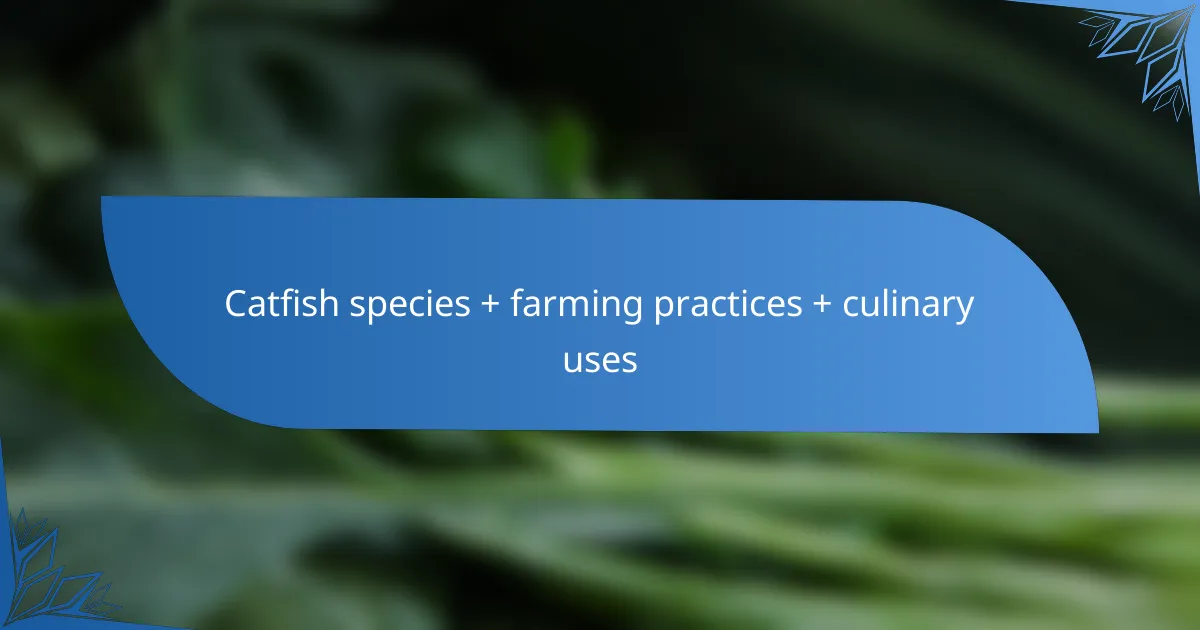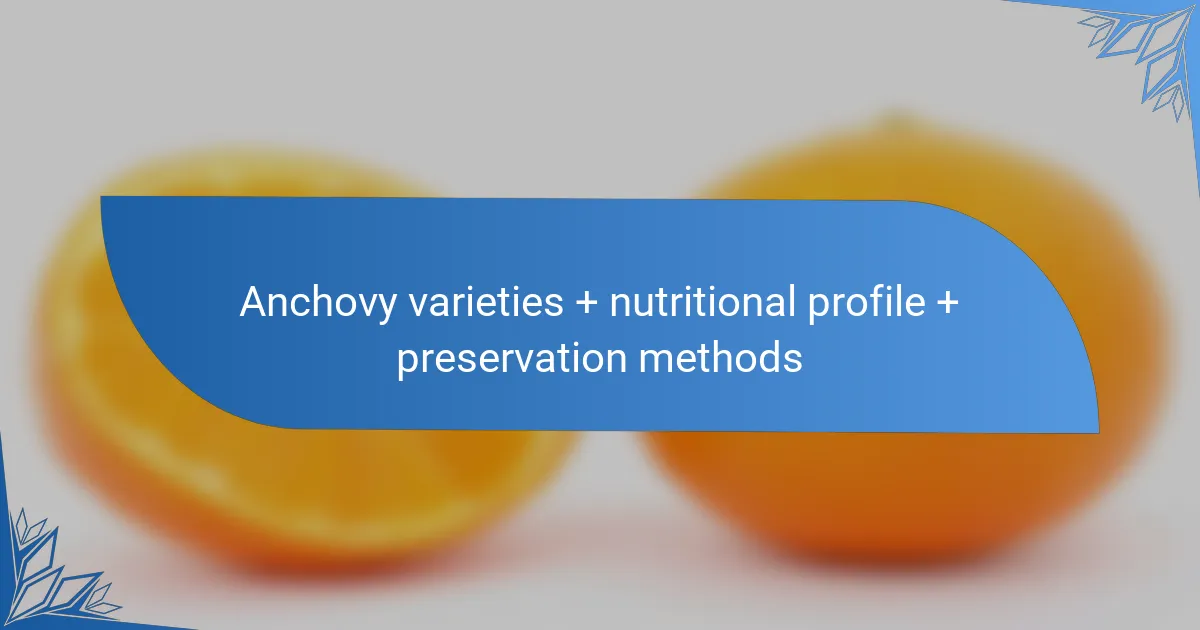
What are the different species of catfish?
There are several species of catfish, including the Channel Catfish, Blue Catfish, and Flathead Catfish. The Channel Catfish is known for its adaptability and is commonly found in North America. Blue Catfish are larger and can weigh over 100 pounds, primarily inhabiting rivers and reservoirs. Flathead Catfish are recognized for their distinctive flat heads and nocturnal feeding habits. Other notable species include the Bullhead Catfish and the Asian Catfish. The diversity of catfish species showcases their ecological significance and culinary versatility.
How do catfish species differ from one another?
Catfish species differ in various attributes such as size, habitat, and diet. For example, the channel catfish can grow up to 58 inches and is commonly found in freshwater rivers and lakes. In contrast, the flathead catfish can reach lengths of 50 inches and prefers deeper waters. Different species also exhibit unique dietary habits; the blue catfish primarily feeds on fish, while the channel catfish consumes a wider variety of food, including insects and crustaceans. Additionally, coloration varies among species, with the blue catfish having a bluish hue, while the channel catfish typically displays a lighter, mottled appearance. These differences impact their farming practices and culinary uses, as each species may require specific conditions for optimal growth and offer distinct flavors in cooking.
What are the key characteristics of popular catfish species?
Popular catfish species exhibit distinct characteristics that make them suitable for aquaculture and culinary uses. The channel catfish is known for its fast growth rate and adaptability to various environments. It can reach sizes of up to 30 pounds and has a mild flavor. The blue catfish is recognized for its large size, often exceeding 100 pounds, and its firm texture. The flathead catfish is distinguished by its unique flat head and preference for live bait, making it popular among anglers. Each species thrives in freshwater environments, contributing to their popularity in farming. Channel catfish are particularly favored in the United States for commercial farming due to their resilience and high yield.
Why is biodiversity important in catfish species?
Biodiversity is important in catfish species because it enhances ecosystem stability and resilience. Diverse catfish populations contribute to various ecological roles, such as nutrient cycling and habitat structure. This diversity allows for better adaptation to environmental changes, ensuring survival during adverse conditions. Studies show that ecosystems with high biodiversity are more productive and sustainable. In aquaculture, maintaining genetic diversity in catfish can improve disease resistance and growth rates. Research indicates that diverse breeding stocks lead to healthier fish populations. Overall, biodiversity in catfish species supports both ecological balance and economic viability in farming practices.
What are the habitats preferred by various catfish species?
Various catfish species prefer diverse habitats. Common habitats include freshwater rivers, lakes, and ponds. Some species thrive in slow-moving waters with ample vegetation. Others inhabit brackish waters near estuaries. Specific species, like the channel catfish, favor muddy bottoms for foraging. The flathead catfish often prefers deeper waters with submerged structures. Tropical species may inhabit warm, shallow waters rich in organic matter. These habitat preferences are crucial for their growth and reproduction.
How do environmental factors influence catfish habitat selection?
Environmental factors significantly influence catfish habitat selection. Catfish prefer areas with suitable water temperature, typically between 70°F and 85°F. They also seek habitats with ample food sources, such as aquatic plants and smaller fish. Oxygen levels in the water are crucial; catfish thrive in well-oxygenated environments. Additionally, water depth and structure, like submerged logs or rocks, provide shelter and breeding grounds. Turbidity levels affect visibility and predation risk, influencing where catfish choose to inhabit. These preferences align with their biological needs for feeding and reproduction, ensuring optimal growth and survival.
What are the geographical distributions of different catfish species?
Different catfish species are distributed across various geographical regions worldwide. The channel catfish is primarily found in North America, particularly in the United States. The flathead catfish inhabits rivers and lakes in the eastern and central United States. The blue catfish is also native to North America, residing in the Mississippi River basin. African catfish are widespread in Africa, particularly in freshwater lakes and rivers. The Mekong giant catfish is found in the Mekong River basin in Southeast Asia. The redtail catfish is native to the Amazon River basin in South America. Each species has adapted to its specific environment, influencing their distribution patterns.

What farming practices are used in catfish aquaculture?
Catfish aquaculture employs several farming practices. These include pond culture, cage culture, and recirculating aquaculture systems (RAS). Pond culture involves stocking catfish in earthen ponds, allowing them to grow naturally. Cage culture utilizes floating cages in lakes or rivers, providing controlled environments for catfish. RAS recycles water, minimizing waste and maximizing fish density.
Feeding practices are crucial in catfish farming. Farmers typically use commercial feed that is high in protein. This promotes faster growth rates and healthier fish. Water quality management is also vital. Farmers monitor parameters like temperature, pH, and dissolved oxygen to ensure optimal conditions.
Disease management practices are implemented to maintain fish health. Regular health checks and vaccinations help prevent outbreaks. Harvesting techniques vary based on the farming method used. Pond-cultured fish are often harvested using seine nets, while cage-cultured fish may be pulled directly from their enclosures.
These practices collectively enhance productivity and sustainability in catfish aquaculture.
How do different farming systems impact catfish production?
Different farming systems significantly impact catfish production. Intensive farming systems often yield higher production rates due to controlled feeding and optimal growth conditions. Research shows that intensive systems can produce up to 10 times more fish per acre compared to extensive systems. Extensive farming relies on natural water bodies and lower stocking densities. This method may result in slower growth rates and lower overall yields. Semi-intensive systems balance both approaches, using supplementary feeding while utilizing natural resources. The choice of farming system influences feed conversion ratios and fish health. Healthier fish from intensive systems typically have better market value. Therefore, the farming system chosen directly affects catfish production efficiency and economic viability.
What are the advantages and disadvantages of pond farming for catfish?
Pond farming for catfish offers several advantages and disadvantages. Advantages include lower operational costs compared to other farming methods. Pond farming allows for natural feeding through aquatic plants and insects, reducing feed expenses. It also provides a controlled environment for breeding and growth, which can enhance fish quality. Additionally, pond farming can lead to higher yields due to optimal water management practices.
However, disadvantages exist as well. Pond farming is susceptible to water quality issues, which can affect fish health. It requires significant land and water resources, which may not be available in all areas. Disease outbreaks can spread rapidly in ponds, leading to substantial losses. Moreover, environmental impacts such as sedimentation and water pollution can arise from pond farming practices.
How does recirculating aquaculture technology work for catfish?
Recirculating aquaculture technology (RAT) for catfish involves a closed-loop system that continuously filters and reuses water. This system minimizes water usage while maintaining optimal conditions for fish growth. Water from catfish tanks is pumped to a filtration system where solids are removed. After filtration, beneficial bacteria convert harmful ammonia into less toxic nitrates. The cleaned water is then returned to the fish tanks, providing a stable environment. RAT allows for higher stocking densities and faster growth rates. Studies show that RAT can increase production efficiency by up to 50% compared to traditional methods. This technology is particularly beneficial in areas with limited water resources.
What are the best practices for managing catfish farms?
Best practices for managing catfish farms include maintaining water quality, proper feeding, and disease management. Water quality should be monitored regularly for pH, ammonia, and dissolved oxygen levels. Ideal pH levels for catfish are between 6.5 and 8.5. Regular water changes help maintain optimal conditions. Feeding should be based on the fish’s growth stage, with high-quality feed provided to ensure proper nutrition. It’s essential to feed catfish at least 2-3 times daily. Disease management involves regular health checks and vaccination protocols to prevent outbreaks. Biosecurity measures should be implemented to minimize disease transmission. Additionally, proper harvesting techniques and record-keeping improve farm efficiency. These practices enhance catfish growth rates and overall farm productivity.
How can farmers ensure optimal growth conditions for catfish?
Farmers can ensure optimal growth conditions for catfish by maintaining proper water quality. This includes monitoring temperature, pH levels, and dissolved oxygen. Catfish thrive in water temperatures between 75°F and 85°F. pH levels should be kept between 6.5 and 8.5 for healthy growth. Dissolved oxygen levels must be above 5 mg/L to support metabolic processes.
Additionally, farmers should provide adequate space and nutrition. Overcrowding can lead to stress and disease. A balanced diet rich in protein and essential nutrients promotes growth and health.
Regularly testing water quality and adjusting feeding practices are crucial. Research indicates that maintaining these conditions can significantly enhance catfish growth rates and overall health.
What role do feed and nutrition play in catfish farming?
Feed and nutrition are critical in catfish farming. They directly impact growth rates, health, and overall production efficiency. Proper feed formulations ensure that catfish receive essential nutrients. These include proteins, carbohydrates, fats, vitamins, and minerals. A well-balanced diet promotes optimal growth and reduces disease susceptibility. Studies show that high-quality feed can increase weight gain by up to 30%. Additionally, nutrition influences feed conversion ratios, which measure how efficiently fish convert feed into body mass. High-quality feed leads to better conversion rates, improving profitability for farmers. Thus, effective feed and nutrition strategies are vital for successful catfish farming.

What are the culinary uses of catfish?
Catfish is commonly used in various culinary applications. It can be fried, grilled, baked, or used in soups and stews. Fried catfish is particularly popular in Southern cuisine. The fish has a mild flavor that absorbs seasonings well. Catfish fillets are often breaded and deep-fried for a crispy texture. Grilled catfish can be marinated for added flavor. In addition, catfish is used in dishes like gumbo and jambalaya. The fish is a good source of protein and omega-3 fatty acids. It is widely available in markets, making it accessible for home cooking.
How is catfish prepared and cooked in different cuisines?
Catfish is prepared and cooked in various ways across different cuisines. In Southern U.S. cuisine, catfish is often breaded and deep-fried. This method enhances its natural flavors and creates a crispy texture. In Asian cuisines, catfish may be grilled or steamed. These techniques preserve the fish’s moisture and tenderness. In Vietnamese cuisine, catfish is commonly used in dishes like “cá kho tộ,” where it is caramelized in a clay pot. In West African cuisine, catfish is often smoked or grilled, adding a distinct flavor profile. Each preparation method highlights the versatility of catfish in culinary practices worldwide.
What are popular dishes featuring catfish?
Popular dishes featuring catfish include catfish fry, catfish stew, and catfish gumbo. Catfish fry is a common preparation where the fish is breaded and deep-fried. This dish is often served with sides like coleslaw and fries. Catfish stew is a hearty dish made with tomatoes, spices, and vegetables. It is popular in Southern cuisine. Catfish gumbo is a flavorful stew originating from Louisiana. It combines catfish with okra, sausage, and a rich roux. These dishes highlight the versatility of catfish in various culinary traditions.
How do cooking methods affect the flavor and texture of catfish?
Cooking methods significantly influence the flavor and texture of catfish. Grilling catfish imparts a smoky flavor and creates a firm texture. Frying catfish results in a crispy exterior while maintaining a moist interior. Baking catfish allows for a tender texture and can enhance the natural flavors with herbs and spices. Steaming catfish preserves moisture and results in a delicate texture. Each method alters the fat content and moisture levels, affecting the overall taste. For instance, frying adds oil, which can enhance richness. Therefore, the chosen cooking method plays a crucial role in the culinary experience of catfish.
What nutritional benefits does catfish offer?
Catfish offers several nutritional benefits. It is a good source of high-quality protein, providing about 20 grams per 3-ounce serving. Catfish is low in calories, with approximately 105 calories in the same serving size. It contains essential omega-3 fatty acids, which are beneficial for heart health. Additionally, catfish provides important vitamins and minerals, including vitamin B12, phosphorus, and selenium. These nutrients support energy metabolism and immune function. The protein content in catfish aids in muscle repair and growth. Overall, catfish is a nutritious option for a balanced diet.
How does the nutritional profile of catfish compare to other fish?
Catfish has a distinct nutritional profile compared to other fish. It typically contains lower levels of omega-3 fatty acids than salmon and mackerel. However, catfish is rich in protein, providing about 20 grams per 100 grams serving. It also offers essential vitamins and minerals, including vitamin B12 and selenium. In terms of calories, catfish is relatively low, averaging around 105 calories per 100 grams. This makes it a healthy option for those seeking lean protein sources. Additionally, catfish has a mild flavor, making it versatile in various culinary applications. Overall, while catfish may lack some omega-3s, it remains a nutritious choice among fish options.
What are the health benefits associated with consuming catfish?
Consuming catfish offers several health benefits. Catfish is a good source of protein, providing about 20 grams per 3-ounce serving. It is low in calories, with approximately 105 calories per serving. This fish contains essential omega-3 fatty acids, which promote heart health. Catfish also provides important vitamins and minerals, including vitamin B12 and selenium. Vitamin B12 supports nerve function and red blood cell production. Selenium acts as an antioxidant, protecting cells from damage. Additionally, catfish is often farmed in sustainable practices, making it an environmentally friendly choice.
What tips can enhance the culinary experience of cooking catfish?
To enhance the culinary experience of cooking catfish, use fresh, high-quality fish. Fresh catfish has a mild flavor that can be complemented with various seasonings. Marinating the fish in citrus juices or buttermilk can tenderize it and add flavor. Cooking methods like grilling, frying, or baking can also affect the taste and texture. For frying, a cornmeal coating provides a crispy exterior. Pairing catfish with sides like coleslaw or cornbread can create a well-rounded meal. Finally, serving with a flavorful sauce, such as tartar or remoulade, enhances the overall experience.
Catfish is a diverse entity encompassing various species, including Channel, Blue, and Flathead Catfish, each with unique attributes such as size, habitat, and dietary preferences. The article explores the ecological significance of catfish biodiversity, their preferred habitats, and the impact of environmental factors on their distribution. It also details aquaculture practices, including pond and recirculating systems, highlighting their advantages and challenges in catfish farming. Additionally, the culinary uses of catfish are examined, showcasing popular cooking methods and the nutritional benefits associated with its consumption.



